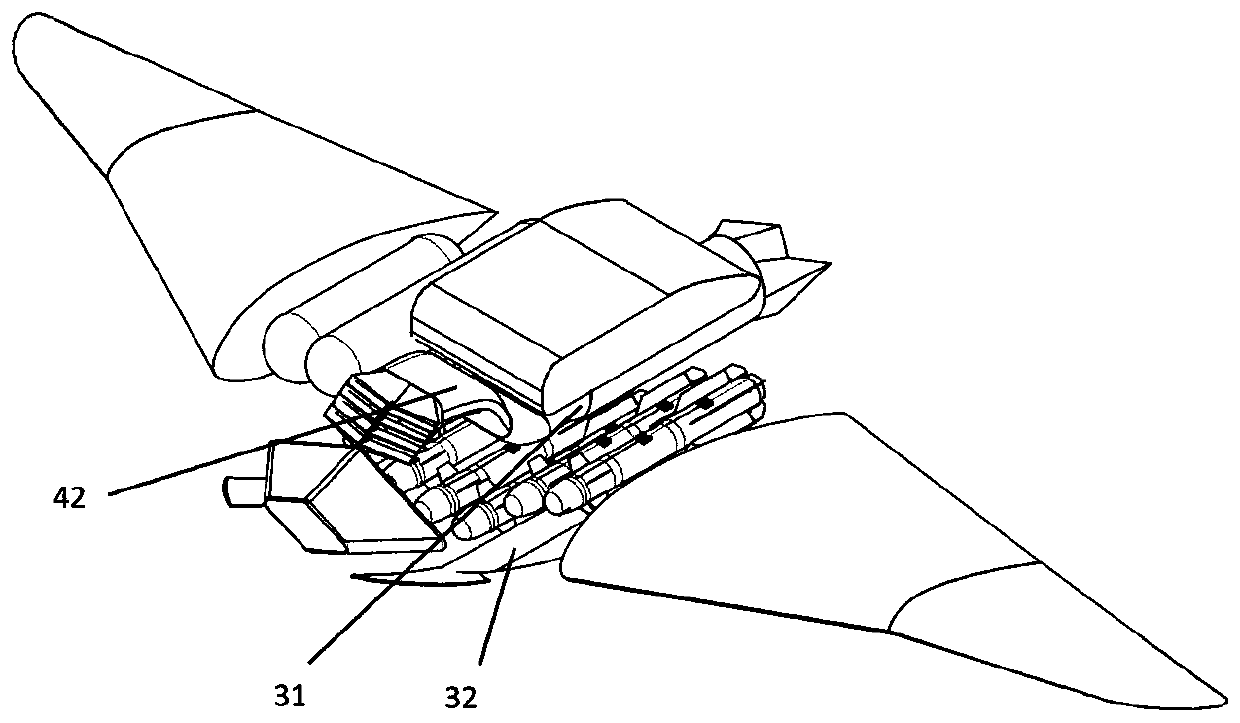A water-air amphibious unmanned aerial vehicle
An unmanned aerial vehicle, water and air technology, applied in the field of unmanned aerial vehicles, to achieve the effects of reducing operating noise and detectability, improving propulsion efficiency and long battery life
- Summary
- Abstract
- Description
- Claims
- Application Information
AI Technical Summary
Problems solved by technology
Method used
Image
Examples
Embodiment 1
[0041] Such as figure 1 , figure 2 , image 3 Shown are respectively the top view, oblique view, and front view of the water-air amphibious unmanned aerial vehicle. The water-air amphibious unmanned aerial vehicle includes: a fuselage and a wing 1, and the fuselage includes: an oil storage device, a power device, an auxiliary device, and a load device.
[0042] The wing 1 improves the maneuverability and maneuverability of the UAV through intelligent active deformation technology, which includes: active bending deformation in the span direction of the wing, active torsional deformation, active continuous variable trailing edge and bistable state Airfoil (low speed / supercritical airfoil). The continuous deformation of the wing is driven by an aerodynamic muscle driver, which has the advantages of light weight, high output force, low cost, etc., and can greatly reduce flight resistance and radar emission signals, thereby improving aerodynamic performance and stealth performa...
Embodiment 2
[0054] In order to change the structure with minimal driving force, the skin structure or material needs to have low deformation stiffness in the deformation direction and high structural stiffness in other non-deformation directions to withstand the corresponding aerodynamic and inertial loads. The invention adopts positive Poisson's ratio honeycomb, negative Poisson's ratio honeycomb or mixed honeycomb design with specific Poisson's ratio, so that the skin has specific rigidity.
[0055] Due to the aerodynamic shape requirements of the aircraft skin, the honeycomb structure cannot be used directly as an aircraft skin, and a smooth flexible panel is required to seal and provide contours. In the present invention, the elastomer material (such as polyurethane flexible matrix) is directly poured into the honeycomb structure, so that the elastomer and the honeycomb wall are fully bonded together to form a whole, avoiding local deformation of the surface, and effectively increasing...
Embodiment 3
[0057] The position where turbulent flow is likely to occur, such as the wing root of the fuselage, adopts an adjustable bionic shark skin structure, so as to exert its drag reduction effect to the greatest extent. The adjustable bionic sharkskin structure is based on the design of the adjustable groove structure of the electroactive polymer, specifically spraying a silver nanowire coating on one side of the electroactive dielectric elastomer according to a certain rule, and coating a flexible electrode on the other side . When an external voltage is applied, the silver nanowires and flexible electrodes on both sides gain energy to move toward each other, squeezing the elastomer causing it to deform. Since the silver nanowires are arranged according to certain rules on the surface of the dielectric body, a regular groove structure is formed on the surface of the elastomer. The size of the groove structure can be adjusted by adjusting the voltage, so as to meet the drag reducti...
PUM
 Login to View More
Login to View More Abstract
Description
Claims
Application Information
 Login to View More
Login to View More - R&D
- Intellectual Property
- Life Sciences
- Materials
- Tech Scout
- Unparalleled Data Quality
- Higher Quality Content
- 60% Fewer Hallucinations
Browse by: Latest US Patents, China's latest patents, Technical Efficacy Thesaurus, Application Domain, Technology Topic, Popular Technical Reports.
© 2025 PatSnap. All rights reserved.Legal|Privacy policy|Modern Slavery Act Transparency Statement|Sitemap|About US| Contact US: help@patsnap.com



